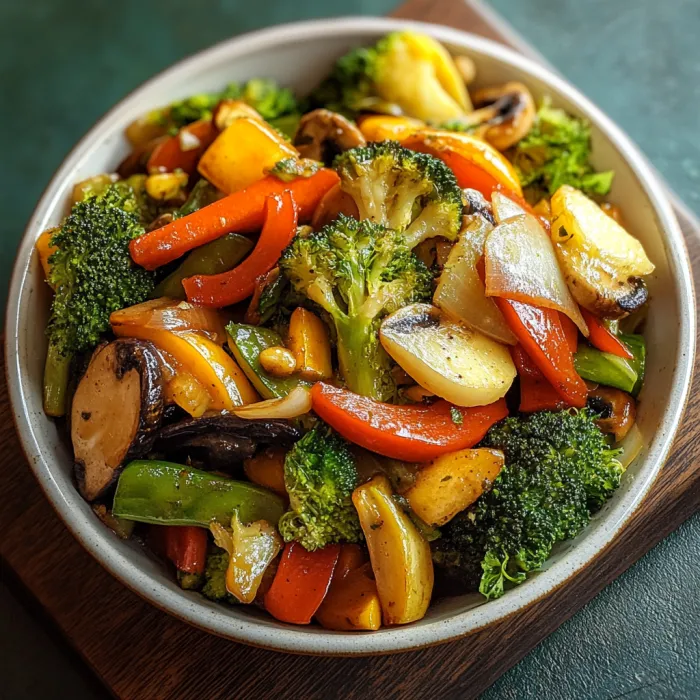 Save
Save
This colorful vegetable stir fry has become my weeknight dinner savior when I need something quick, nutritious, and flavorful. The vibrant medley of vegetables comes together in just 25 minutes, making it perfect for busy evenings when you want a homemade meal without spending hours in the kitchen.
I first developed this recipe during a busy work week when I needed to use up vegetables in my fridge. What started as a simple clean-out-the-fridge meal has become a regular in our dinner rotation, with my family requesting it specifically on Meatless Mondays.
Ingredients
- Carrots sliced thin on diagonal for quick cooking and maximum flavor absorption
- Broccoli florets cut uniformly to ensure even cooking throughout
- Baby corn adds a sweet crunch and unique texture to the dish
- Mushrooms provide an earthy umami flavor that deepens the overall taste
- Cabbage offers volume and soaks up all the delicious sauce
- Oil with a high smoke point like peanut or vegetable ensures proper stir fry technique
- Fresh garlic and ginger form the aromatic foundation of authentic Asian flavors
- Soy sauce provides the essential savory saltiness for the sauce
- Oyster sauce adds a complex sweetness and depth though can be omitted for vegetarian version
- Cornstarch and water mixture transforms the liquid ingredients into a silky sauce that coats each vegetable
Step-by-Step Instructions
- Prepare All Vegetables
- Cut all vegetables before heating the wok as stir frying happens quickly and requires immediate attention once started. Make sure carrots are sliced thinly enough to cook in the same time as other vegetables. Having everything within arms reach of your cooking area saves time and prevents burning.
- Heat Your Wok
- Bring your wok or large skillet to a proper high heat before adding oil. The oil should shimmer but not smoke. This step is crucial for achieving that authentic stir fry sear on vegetables rather than steaming them.
- Aromatics First
- Add minced garlic and ginger to the hot oil and stir constantly for exactly 30 seconds. This releases their essential oils and flavors without burning them which would create bitterness.
- Stagger Vegetable Addition
- Add harder vegetables like carrots, broccoli, and baby corn first since they require longer cooking time. Keep them moving constantly in the hot wok to prevent sticking and ensure even cooking on all sides.
- Second Vegetable Addition
- Introduce softer vegetables like mushrooms and cabbage after the harder vegetables have had a head start. The key is maintaining the wok's high heat while stirring continuously to achieve that perfect crisp tender texture.
- Create The Sauce
- Pour your liquid seasonings around the sides of the wok rather than directly onto the vegetables. This allows the sauce to heat quickly and starts the thickening process instantly when you add the cornstarch slurry.
- Final Toss
- Use a folding motion rather than stirring to coat vegetables with sauce without breaking or mushing them. The sauce should thicken just enough to cling to each vegetable piece creating a glossy finish.
 Save
Save
The fresh ginger is my secret weapon in this recipe. When I first started making stir fries, I used powdered ginger but discovered that fresh ginger root completely transforms the dish. I keep a knob in my freezer and grate it directly into the wok for maximum flavor with minimal effort.
Vegetable Substitutions
This stir fry recipe is incredibly forgiving and adaptable based on what vegetables you have available. Bell peppers, snow peas, zucchini, or snap peas work wonderfully in place of or in addition to any of the listed vegetables. The key is cutting everything into similar sized pieces for even cooking. If using leafy greens like spinach or bok choy, add them during the final minute of cooking as they wilt quickly.
Protein Additions
Turn this vegetable stir fry into a complete meal by adding your favorite protein. For a vegetarian version, toss in cubed firm tofu or tempeh during the first vegetable addition. Meat eaters can add thinly sliced chicken, beef, or shrimp marinated in a tablespoon of soy sauce. Cook the protein first, remove from the wok, then proceed with the vegetable stir fry and return the protein at the end to warm through.
Sauce Variations
While the simple soy and oyster sauce combination creates a beautiful balance, you can customize the flavor profile based on your preferences. For spicy heat, add a teaspoon of chili garlic paste or sriracha. Create a sweeter profile with a tablespoon of hoisin sauce or honey. For a Thai inspired version, stir in a tablespoon of creamy peanut butter and fresh lime juice after removing from heat.
Serving Suggestions
While traditionally served over steamed rice, this versatile stir fry pairs beautifully with many bases. Try it over noodles like soba, udon, or rice noodles for a different texture experience. For a lower carb option, serve it atop cauliflower rice or alongside a simple protein like grilled chicken or fish. The leftovers even make a fantastic cold lunch the next day when tossed with cooked quinoa and a splash of rice vinegar.
Recipe FAQs
- → What vegetables work best in a stir fry?
The best vegetables for stir fry are those that cook quickly and maintain texture. Besides the carrots, broccoli, baby corn, mushrooms, and cabbage in this dish, consider bell peppers, snow peas, sugar snap peas, bok choy, water chestnuts, or bean sprouts. Choose vegetables with similar cooking times or add them in stages, starting with firmer vegetables first.
- → How do I prevent my vegetables from becoming soggy?
To keep vegetables crisp, ensure your wok or pan is very hot before adding ingredients, cut vegetables uniformly for even cooking, and avoid overcrowding the pan which causes steaming instead of stir-frying. Cook vegetables in batches if necessary, and remember that vegetables will continue cooking slightly after removed from heat, so aim for tender-crisp rather than fully soft.
- → Can I make this dish vegan?
Yes! Simply omit the oyster sauce or replace it with vegetarian oyster sauce (made from mushrooms). You can enhance umami flavors with additional soy sauce, a dash of mushroom powder, or a splash of vegetable broth. Many Asian markets and grocery stores carry vegan stir fry sauce alternatives that work perfectly.
- → What protein can I add to make this a more complete meal?
This stir fry pairs wonderfully with tofu, tempeh, seitan, chicken, beef, pork, or shrimp. For plant-based proteins, press and cube tofu before frying until golden, then add back with the sauce. For meat, slice thinly against the grain and cook first until nearly done, remove, then add back during the final sauce step to prevent overcooking.
- → How can I make the stir fry sauce more flavorful?
Enhance the sauce by adding a tablespoon of hoisin sauce for sweetness, sriracha or chili oil for heat, a splash of rice vinegar for acidity, or a teaspoon of sesame oil for nuttiness. Fish sauce adds depth (use sparingly), while a tablespoon of brown sugar or honey creates nice caramelization. Experiment with Chinese five-spice powder or a dash of white pepper for complexity.
- → Can I prepare components of this dish ahead of time?
Absolutely! Chop all vegetables up to 2 days ahead and store in airtight containers in the refrigerator. Mix the sauce ingredients (except cornstarch slurry) and refrigerate up to 3 days. Prepare the cornstarch slurry just before cooking. Having everything prepped ahead makes this an incredibly quick meal to assemble when you're ready to cook.
